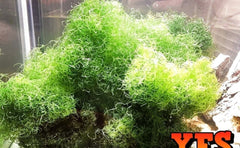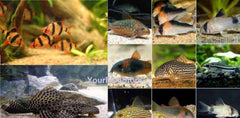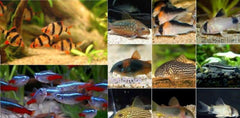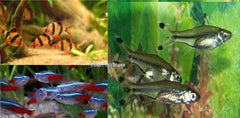X1 Silver Arowana Sml + X10 Cichlids - Freshwater
Ebay
$ 154.53

x1 SILVER AROWANA SML OSTEOGLOSSUM BIRCIRRHOSUM FRESHWATER LIVE FISH
Approx 3"-4" Each
+ x10 CICHLIDS - FRESHWATER LIVE FISH
*This Package Include x10 Hand Pick Cichlids*
We will add a random x10 sm/md (1" - 2") cichlids to your order
Minimum Tank Size: 75 Gallons
Care Level: Very Difficult
Water Conditions: 6.0-7.0 pH and Soft to Moderately Hard
Temperature: 75-82° F (24-27° C)
Maximum Size: 36 inches (91.5 centimeters)
The Arowana Osteoglossum bicirrhosum was first introduced into the aquarium hobby in 1912. This fish provides us with a glimpse into the past. It is one of only a few living examples of our ancient prehistoric world of the Jurassic age. Its scientific name is derived from the Greek terms "Osteoglossum" which means "bone-tongued" and "bicirrhosum" which means "two barbels". So basically this as a bony-tongued fish with two barbels. Because of its coloration it is also known as a Silver Arowana. It has a few different spellings, so it can be found as a Silver Aruana, Silver Arawana, and Silver Arrowanas. But all these common names are representative of the same species.
The Silver Arowana is one of the most interesting fish and it can get very large. It is a long fish with a fluid, almost snake-like swimming motion. A maximum sized specimen would reach up to 47 inches (120 cm) in length and need an aquarium of at least 4 feet wide and 4 feet long just to turn around. A specimen of that size is pretty rare in the aquarium, generally they are smaller with 24 to 30 inches (60 - 78 cm) being a good sized Arowana. It is basically a silver fish, but its scales are very large. As this fish matures the scales develop an opalescent effect that will reflect blue, red, and green highlights. This has led to the nickname "Dragonfish" when seen in the wild.
One of the most curious characteristics of this fish are its mouth. It opens in three pieces and looks similar to a loading barge, definitely indicative of its predatory nature and appetite. The two distinctive barbels at the tip of the lower jaw are great sensory devices. With them, it can sense and capture prey on the surface of the water, even in total darkness. Its eyesight is also remarkable. With a keen vision, this fish can see above the surface, spotting and leaping out of the water to strike insects and birds from over hanging tree branches. This has lead to still another nickname for this fish, the "Water Monkey".
Though they can be kept together when small, larger specimens are best kept singly or with other species of larger fish. They are a predator and will eat small fish. But on a positive note, they can become quite tame and take food from your fingers.
These fish are excellent jumpers and very strong, so make sure the top of the aquarium is securely covered. The Arowana will prefer an aquarium with a fine gravel bottom, planted loosely with hardy plants, and have open areas on the top to swim.
For best results they should be provided with a highly varied diet. Shrimp, prawns, mealworms, crickets, centipedes, krill and frogs are all suitable foods, though any sharp pieces should first be removed and live animals should be quarantined first to avoid the introduction of parasites.
Arowanas enjoy eating smaller fish but should not be fed these too often, as a build-up of fat in their bodies can lead to health problems. Many arowanas will take pellet food, but this is not sufficient on a daily basis.
Individual preferences vary, so be ready to experiment to see what your arowanas like.
Because arowanas are so active and tend to swim fast, you should avoid having any sharp objects in your aquarium on which they might injure themselves. Fast flowing water will keep them in better condition as it will discourage them from rubbing against the glass.
Arowanas in aquariums often suffer from protruding, drooping eyes due to looking downwards a lot, which they should not do in the wild.
A good way to avoid this is to keep a brightly coloured ping pong ball floating on the surface of the water. This will distract them sufficiently to keep their eyes in good condition and they'll enjoy playing with it, giving you something extra to enjoy watching.
Arowanas are extremely difficult to breed in captivity, especially in an aquarium. They spend months courting to develop pair bonds and spawn just once a year. If they do breed successfully, the male will protect the eggs, and later the fry, in his mouth. However, the female may eat them, so it is best to separate her at this stage.
Customer Reviews
No reviews yet
Write a review
QUESTIONS & ANSWERS
Have a Question?
Be the first to ask a question about this.















